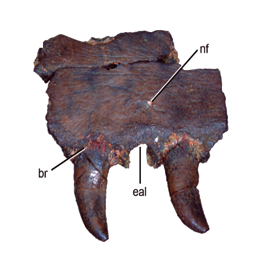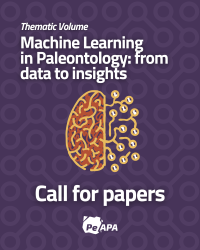ADDITIONAL INFORMATION ON THE ARCHOSAURIFORMS FROM THE LOWERMOST TRIASSIC PANCHET FORMATION OF INDIA AND THE AFFINITIES OF “TERATOSAURUS(?) BENGALENSIS”
DOI:
https://doi.org/10.5710/PEAPA.26.02.2024.496Keywords:
Archosauriformes, Proterosuchidae, Induan, TaxonomyAbstract
The Panchet Formation of northeastern India preserves an Induan (earliest Triassic) vertebrate assemblage with only one valid archosauromorph species, the proterosuchid Samsarasuchus pamelae. Two other archosauromorph species have been named for this unit: “Ankistrodon indicus” and “Teratosaurus(?) bengalensis”. “Ankistrodon indicus”, based on a fragment of maxilla with two partial teeth, is indistinguishable from other proterosuchid species and is considered a nomen dubium. “Teratosaurus(?) bengalensis” is represented by an isolated, almost complete tooth that was distinguished from “Ankistrodon indicus” in the presence of mesial denticles. “Teratosaurus(?) bengalensis” is also indistinguishable from other valid proterosuchid species and considered likely a nomen dubium. However, it remains unresolved if “Teratosaurus(?) bengalensis” represents a second Panchet archosauromorph species different from Samsarasuchus pamelae and “Ankistrodon indicus” because the presence of mesial denticles cannot be determined in these species due to their incompleteness. Here we describe two new Panchet Proterosuchidae specimens collected from the same locality as the holotypes of the three above-mentioned species. These new specimens are maxillary fragments and one of them has almost complete teeth with mesial denticles on the apical portion of the crowns, as in “Teratosaurus(?) bengalensis.” The rest of their morphology is congruent with that of Samsarasuchus pamelae and “Ankistrodon indicus.” As a result, the specimens reported here expand our anatomical knowledge of the Panchet archosauriform assemblage and indicate that there is no current evidence for the presence of more than one valid archosauromorph species in the Panchet Formation.
References
Acharyya, S. K. (2003). The nature of Mesoproterozoic Central Indian Tectonic Zone with exhumed and reworked older granulites. Gondwana Research, 6, 197-214.
Bakker, R. T. (1977). Tetrapod mass extinctions—a model of the regulation of speciation rates and immigration by cycles of topographic diversity. In A. Hallan (Ed.), Patterns of Evolution as Illustrated by the Fossil Record (pp. 439–468). Elsevier Scientific Publishing Company.
Bandyopadhyay, S. (1999). Gondwana vertebrate faunas of India. Proceedings of the Indian National Science Academy, 65, 285–313.
Bandyopadhyay, S. (2011). Non-marine Triassic vertebrates of India. In J. O. Calvo, J. Porfiri, B. Gonzalez Riga and D. Dos Santos (Eds.), Paleontología y dinosaurios desde América Latina (pp. 33–46). EDIUNC, Editorial de la Universidad Nacional de Cuyo.
Bandyopadhyay, S. and Ray, S. (2020). Gondwana vertebrate faunas of India: their diversity and intercontinental relationships. Episodes Journal of International Geoscience, 43, 438–460.
Benton, M. J., Tverdokhlebov, V. P. and Surkov, M. V. (2004). Ecosystem remodelling among vertebrates at the Permo-Triassic boundary in Russia. Nature, 432, 97–100.
Borsuk−Białynicka, M. and Evans, S. E. (2009). Cranial and mandibular osteology of the Early Triassic archosauriform Osmolskina czatkowicensis from Poland. Palaeontologia Polonica, 65, 235–281.
Brusatte, S. L., Butler, R. J., Sulej, T. and Niedźwiedzki, G. (2009). The taxonomy and anatomy of rauisuchian archosaurs from the Late Triassic of Germany and Poland. Acta Palaeontologica Polonica, 54, 221–230.
Butler, R. J., Ezcurra, M. D., Liu, J., Sookias, R. B. and Sullivan, C. (2019a). The anatomy and phylogenetic position of the erythrosuchid archosauriform Guchengosuchus shiguaiensis from the earliest Middle Triassic of China. PeerJ, 7, e6435.
Butler, R. J., Sennikov, A. G., Dunne, E. M., Ezcurra, M. D., Hedrick, B. P., Maidment, S. C., Meade, L. E., Raven, T. J. and Gower, D. J. (2019b). Cranial anatomy and taxonomy of the erythrosuchid archosauriform ‘Vjushkovia triplicostata’ Huene, 1960, from the Early Triassic of European Russia. Royal Society Open Science, 6, 191289.
Butler, R. J., Sennikov, A. G., Ezcurra, M. D. and Gower, D. J. (2019c). The last erythrosuchid? A revision of Chalishevia cothurnata Ochev, 1980 from the late Middle Triassic of European Russia. Acta Palaeontologica Polonica, 64, 757–774.
Charig, A. J. and Reig, O. A. (1970). The classification of the Proterosuchia. Biological Journal of the Linnean Society, 2, 125–171.
Charig, A. J. and Sues, H.-D. (1976). Proterosuchia. In O. Kuhn (Ed.), Handbuch der Paläoherpetologie, volume 13 (pp. 11–39). Gustav Fischer Verlag.
Chen, Z. Q. and Benton, M. J. (2012). The timing and pattern of biotic recovery following the end−Permian mass extinction. Nature Geoscience, 5, 375−383.
Cosgriff, J. W. (1984). The temnospondyl labyrinthodonts of the earliest Triassic. Journal of Vertebrate Paleontology, 4, 30–46.
Das, D. P. and Gupta, A. (2012). New cynodont record from the lower Triassic Panchet Formation, Damodar valley. Journal of the Geological Society of India, 79, 175–180.
Dasgupta, H. C. (1922). Notes on the Panchet reptile. Sir Asutosh Mukherjee Silver Jubilee Volumes, 2, 237–241.
Dasgupta, H. C. (1926). Palaeontological notes on the Panchet Beds at Deoli, near Asansol. The Journal of the Asiatic Society of Bengal, 22, 215–217.
Dasgupta, H. C. (1928). Batrachian and reptilian remains found in the Panchet Beds at Deoli. Bengal. The Journal of the Asiatic Society of Bengal, 24, 473–479.
De-Oliveira, T. M., Oliveira, D., Schultz, C. L., Kerber, L. and Pinheiro, F. L. (2018). Tanystropheid archosauromorphs in the Lower Triassic of Gondwana. Acta Palaeontologica Polonica, 63, 713–723.
De-Oliveira, T. M., Pinheiro, F. L., Stock Da-Rosa, Á. A., Dias-Da-Silva, S. and Kerber, L. (2020). A new archosauromorph from South America provides insights on the early diversification of tanystropheids. PLoS One, 15, e0230890.
De-Oliveira, T. M., Kerber, L., França, M. A. G. D. and Pinheiro, F. L. (2022). Archosauriform remains from the Lower Triassic Sanga do Cabral Formation of Brazil. Journal of Vertebrate Paleontology, 41, e2068022.
Dilkes, D. W. (1998). The Early Triassic rhynchosaur Mesosuchus browni and the interrelationships of basal archosauromorph reptiles. Philosophical Transactions of the Royal Society of London B, 353, 501–541.
Erwin, D. H. (1994). The Permo–Triassic extinction. Nature, 367, 231–236.
Ezcurra, M. D. (2014). The osteology of the basal archosauromorph Tasmaniosaurus triassicus from the Lower Triassic of Tasmania, Australia. PLoS One, 9, e86864.
Ezcurra, M. D. (2016). The phylogenetic relationships of basal archosauromorphs, with an emphasis on the systematics of preterosuchian archosauriforms. PeerJ, 4, e1778.
Ezcurra, M. D. and Butler, R. J. (2015). Taxonomy of the proterosuchid archosauriforms (Diapsida: Archosauromorpha) from the earliest Triassic of South Africa, and implications for the early archosauriform radiation. Palaeontology, 58, 141−170.
Ezcurra, M. D. and Butler, R. J. (2018). The rise of the ruling reptiles and ecosystem recovery from the Permian-Triassic mass extinction. Proceedings of the Royal Society London, 285, 20180361.
Ezcurra, M. D., Butler, R. J. and Gower, D. J. (2013). ‘Proterosuchia’: the origin and early history of Archosauriformes. In S. J. Nesbitt, J. B. Desojo and R. B. Irmis (Eds.), Anatomy, phylogeny and palaeobiology of early archosaurs and their kin (pp. 9–33). Geological Society, Special Publication 379.
Ezcurra, M. D., Scheyer, T. and Butler, R. J. (2014). The origin and early evolution of Sauria, reassessing the Permian saurian fossil record and the timing of the crocodile-lizard divergence. PLoS One, 9, e89165.
Ezcurra, M. D., Desojo, J. B. and Rauhut, O. W. M. (2015). Redescription and phylogenetic relationships of the proterochampsid Rhadinosuchus gracilis (Diapsida: Archosauriformes) from the early Late Triassic of southern Brazil. Ameghiniana, 52, 391–417.
Ezcurra, M. D., Gower, D. J., Sennikov, A. G. and Butler, R. J. (2019). The osteology of the holotype of the early erythrosuchid Garjainia prima Ochev, 1958 (Diapsida: Archosauromorpha) from the upper Lower Triassic of European Russia. Zoological Journal of the Linnean Society, 185, 717–783.
Ezcurra, M. D., Jones, A. S., Gentil, A. R. and Butler, R. J. (2021). Early Archosauromorphs: the Crocodile and Dinosaur Precursors. In D. Alderton and S. A. Elias (Eds.), Encyclopedia of Geology, 2nd edition, vol. [4] (pp. 175–185). Academic Press.
Ezcurra, M. D., Bandyopadhyay, S. and Sen, K. (2022). A new faunistic component of the Lower Triassic Panchet Formation of India increases the continental non-archosauromorph neodiapsid record in the aftermath of the end-Permian mass extinction. Journal of Paleontology, 96, 428–438.
Ezcurra, M. D., Bandyopadhyay, S., Sengupta, D. P., Sen, K., Sennikov, A. G., Sookias, R. B., Nesbitt, S. J. and Butler, R. J. 2023 A new archosauriform species from the Panchet Formation of India and the diversification of Proterosuchidae after the end-Permian mass extinction. Royal Society Open Science, 10, 230387.
Flynn, J. J., Nesbitt, S. J., Parrish, J. M., Ranivoharimanana, L. and Wyss, A. R. (2010). A new species of Azendohsaurus (Diapsida: Archosauromorpha) from the Triassic Isalo Group of southwestern Madagascar: cranium and mandible. Palaeontology, 53, 669–688.
Fraser, N. C. (1982). A new rhynchocephalian from the British Upper Triassic. Palaeontology, 25, 709–725.
Gastaldo, R. A., Kamo, S. L., Neveling, J., Geissman, J. W., Looy, C. V. and Martini, A. M. (2020). The base of the Lystrosaurus Assemblage Zone, Karoo Basin, predates the end-Permian marine extinction. Nature Communications, 11, 1428.
Ghosh, S. C., Nandi, A., Ahmed, G. and Roy, D. K. (1996). Study of Permo–Triassic boundary in Gondwana sequence of Raniganj Basin. In: Proceedings IXth International Gondwana Symposium (pp. 195–206). Oxford and IBH Publications.
Gottmann-Quesada, A. and Sander, P. M. (2009). A redescription of the early archosauromorph Protorosaurus speneri Meyer, 1832, and its phylogenetic relationships. Palaeontographica Abteilung A, 287, 123–220.
Gower, D. J. (2003). Osteology of the early archosaurian reptile Erythrosuchus africanus Broom. Annals of the South African Museum, 110, 1–84.
Gower, D. J. and Sennikov, A. G. (2000). Early archosaurs from Russia. In M. J. Benton, E. N. Kurochkin, M. A. Shishkin and D. M. Unwin (Eds.), The age of dinosaurs in Russia and Mongolia (pp. 140–159). Cambridge University Press.
Gower, D. J., Hancox, P. J., Botha-Brink, J., Sennikov, A. G. and Butler, R. J. (2014). A new species of Garjainia Ochev, 1958 (Diapsida: Archosauriformes: Erythrosuchidae) from the Early Triassic of South Africa. PLoS ONE, 9, e111154.
Gupta, A. (2005). Environment and tetrapod ecology of the Panchet Formation of Upper Gondwana, Damodar Valley Basin, West Bengal [Unpublished Report Geological Survey of India 21].
Gupta, A. (2009). Ichthyofauna of the Lower Triassic Panchet Formation, Damodar valley basin, West Bengal, and its implications. Indian Journal of Earth Sciences, 63, 275–286.
Hamley, T., Cisneros, J. C. and Damiani, R. (2021). A procolophonid reptile from the Lower Triassic of Australia. Zoological Journal of the Linnean Society, 192, 554–609.
Huxley, T. H. (1865). On a collection of vertebrate fossils from the Panchet Rocks, Ranigunj, Bengal. Memoirs of the Geological Survey of India, 3, 1–24.
Kear, B. P. (2009). Proterosuchid archosaur remains from the Early Triassic Bulgo Sandstone of Long Reef, New South Wales. Alcheringa, 33, 331–337.
McLoughlin, S., Mays, C., Vajda, V., Bocking, M., Frank, T. D. and Fielding, C. R. (2020). Dwelling in the dead zone—vertebrate burrows immediately succeeding the end-Permian extinction event in Australia. Palaios, 35, 342–357.
Miedema, F, Spiekman, S. N., Fernandez, V., Reumer, J. W. and Scheyer, T. M. (2020). Cranial morphology of the tanystropheid Macrocnemus bassanii unveiled using synchrotron microtomography. Scientific Reports, 10, 1–19.
Modesto, S. P. and Sues, H.-D. (2004). The skull of the Early Triassic archosauromorph reptile Prolacerta broomi and its phylogenetic significance. Zoological Journal of the Linnean Society, 140, 335¬–351.
Murthy, S., Chakraborti, B. and Roy, M. D. (2010). Palynodating of subsurface sediments, Raniganj Coalfield, Damodar Basin, West Bengal. Journal of Earth System Science, 119, 701–710.
Nesbitt, S. J. (2011). The early evolution of archosaurs: relationships and the origin of major clades. American Museum of Natural History, 352, 1–292.
Pal, S. (2021). Fossil remains of proterosuchian from the Panchet Formation, Damodar valley of India. Current Science, 120, 1749–1752.
Pascoe, E. W. (1956). A Manual of the Geology of India and Burma [Manager of Publications, Government of India, New Delhi].
Patel, R. C., Sinha, H. N., Anupam Kumar, B. and Singh, P. (2014). Basin provenance and post-depositional thermal history along the continental P/T boundary of the Raniganj basin, eastern India: constraints from apatite fission track dating. Journal of the Geological Society of India, 83, 403–413.
Pinheiro, F. L., França, M. A. G., Lacerda, M. B., Butler, R. J. and Schultz, C. L. (2016). An exceptional fossil skull from South America and the origins of the archosauriform radiation. Scientific Reports, 6, 22817.
Pinheiro, F. L., De Simão-Oliveira, D. and Butler, R. J. (2020). Osteology of the archosauromorph Teyujagua paradoxa and the early evolution of the archosauriform skull. Zoological Journal of the Linnean Society, 189, 378–417.
Raup, D. M. (1979). Size of the Permo-Triassic bottleneck and its evolutionary implications. Science, 206, 217–218.
Ray, S. (2005). Lystrosaurus (Therapsida, Dicynodontia) from India: taxonomy, relative growth and cranial dimorphism. Journal of Systematic Palaeontology, 3, 203–221.
Robinson, P. L. (1958). Some new vertebrate fossils from the Panchet Series of West Bengal. Nature, 182, 1722–1723.
Romano, M., Bernardi, M., Petti, F. M., Rubidge, B., Hancox, J. and Benton, M. J. (2020). Early Triassic terrestrial tetrapod fauna: a review. Earth-Science Reviews, 210, 103331.
Sennikov, A. G. (1995). Early thecodonts of Eastern Europe. Trudy Paleontological Institute RAN, 263, 1–141. [In Russian]
Smith, R. M. H. and Botha, J. (2005). The recovery of terrestrial vertebrate diversity in the South African Karoo Basin after the end-Permian extinction. Comptes Rendus Palevol, 4, 623–636.
Smith, R. M. H. and Botha-Brink, J. (2014). Anatomy of a mass extinction: sedimentological and taphonomic evidence for drought-induced die-offs at the Permo-Triassic boundary in the main Karoo Basin, South Africa. Palaeogeography, Palaeoclimatology, Palaeoecology, 396, 99−118.
Sookias, R. B., Dilkes, D., Sobral, G., Smith, R. M., Wolvaardt, F. P., Arcucci, A. B., Bhullar, B.-A. and Werneburg, I. (2020). The craniomandibular anatomy of the early archosauriform Euparkeria capensis and the dawn of the archosaur skull. Royal Society Open Science, 7, 200116.
Tatarinov, L. P. (1960). Discovery of pseudosuchians in the Upper Permian of SSSR. Paleontological Journal, 1960, 74–80. [in Russian]
Tripathi, C. & Satsangi, P. P. (1963). Lystrosaurus fauna of the Panchet series of the Raniganj coalfield. Memoirs of the Geological Survey of India, Palaeontologia Indica, new series, 37, 1–65.
Viglietti, P. A., Rojas, A., Rosvall, M., Klimes, B. and Angielczyk, K. D. (2022). Network‐based biostratigraphy for the late Permian to mid‐T riassic Beaufort Group (Karoo Supergroup) in South Africa enhances biozone applicability and stratigraphic correlation. Palaeontology, 65, e12622.
von Huene, F. (1942). Die fossilen Reptilien des südamerikanischen Gondwanalandes. Ergebnisse der Sauriergrabungen in Südbrasilien 1928/29. Lieferungen 3-4 (Pseudosuchia, Saurischia, Rhynchocephalia, Schlussliefereung). [C. H. Beck'sche Verlagsbuchhandlung, München].
Welman, J. (1998). The taxonomy of the South African proterosuchids (Reptilia, Archosauromorpha). Journal of Vertebrate Paleontology,
, 340−347.
Young, C. C. (1973). Prolacertoides jimusarensis. Vertebrata PalAsiatica, 11, 46–48.

Downloads
Published
Issue
Section
License
Copyright (c) 2024 KONGRAILATPAM MILANKUMAR SHARMA, MARTIN EZCURRA, RAGHAVENDRA PRASAD TIWARI, RAJEEV PATNAIK, YUMLEMBAM PRIYANANDA SINGH, NONGMAITHEM AMARDAS SINGH

This work is licensed under a Creative Commons Attribution-NoDerivatives 4.0 International License.
Authors retain copyright and grant the journal right of first publication with the work simultaneously licensed under a Atribución/Reconocimiento 4.0 Internacional that allows others to share the work with an acknowledgement of the work's authorship and initial publication in this journal.
















